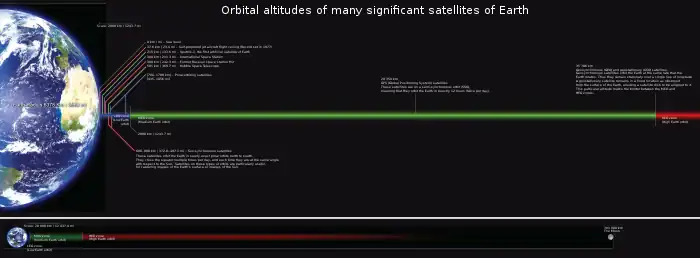High Earth orbit
High Earth orbit (HEO) is a region of space around the Earth where satellites and other spacecraft are placed in orbits that are very high above the planet's atmosphere. This area is defined as an altitude higher than 35,786 km (22,236 mi) above sea level,[1] which is the radius of a circular geosynchronous orbit. HEO extends to end of the Earth's sphere of influence. Satellites in HEO are primarily used for communication, navigation, scientific research, and military applications.[2] A variety of satellites, such as TESS,[3] have been placed in HEO.

One of the main benefits of HEO is that it provides a nearly unobstructed view of the Earth and deep space. This makes it an ideal location for astronomical observations and Earth monitoring. In addition, satellites in HEO can provide a continuous coverage of the Earth's surface, making it very useful for communication and navigation purposes.[4]
There are four main reasons that most satellite are placed in lower orbits. First, a HEO can take a month or more per orbit. This is because HEOs are very large orbits and move at only 7000 mph. Meanwhile, a LEO (low Earth orbit) can take less than 90 minutes.[5] So, for satellites that need to orbit quickly, HEO is not a good fit. Second, HEOs take far more energy to place a satellite into than LEOs. To place a satellite into HEO takes nearly as much energy as to place it into a heliocentric orbit. For example, an expended Falcon 9 can carry 50,000 pounds to LEO. However, it can only carry around 10,000 pounds to HEO. [6] This means that it costs 5 times more to place a payload in HEO versus placing it in LEO. Third, HEOs are incredibly far from Earth. This means that there is a constant communication delay when sending signals to and from the satellite. This is actually because the signals can only travel at the speed of light. This means that it can take around 0.1 to 4.5 seconds in delay time each way. This makes it useless for internet, and hard to use for other things as well. The fourth reason is radiation. HEO is outside of the magnetic field of Earth. This means that there is far more radiation in HEO. As a result, spacecraft in HEO require specialized equipment and shielding to protect them from radiation. As a result, only satellites that require the unique characteristics of HEO use this orbit.
The development of HEO technology has had a significant impact on space exploration and has paved the way for future missions to deep space. The ability to place satellites in HEO has allowed scientists to make groundbreaking discoveries in astronomy and Earth science, while also enabling global communication and navigation systems.[7]
Examples of satellites in high Earth orbit
| Name | NSSDC id. | Launch date | Perigee | Apogee | Period | Inclination |
|---|---|---|---|---|---|---|
| Vela 1A[8][9] | 1963-039A | 1963-10-17 | 101,925 km | 116,528 km | 108 h 39 min | 37.8° |
| IBEX | 2008-051A | 2008-10-19 | 61,941 km | 290,906 km | 216 h 3 min | 16.9° |
| TESS[3][10] | 2018-038A | 2018-04-18 | 108,000 km | 375,000 km | 328 h 48 min | 37.00° |
References
- "Catalog of Earth Satellite Orbits". earthobservatory.nasa.gov. 2009-09-04. Retrieved 2023-04-05.
- "Types of Orbits". spacefoundation.org. Retrieved April 22, 2023.
- "MIT TESS mission". Retrieved November 12, 2022.
- "Advantages of HEO Highly Elliptical Orbit | Disadvantages of HEO orbit".
- "Popular Orbits 101". Aerospace Security. 30 November 2017. Retrieved 2023-04-05.
- "Capabilities & Services" (PDF). spacex.com. Retrieved April 22, 2023.
- "Catalog of Earth Satellite Orbits". earthobservatory.nasa.gov. 2009-09-04. Retrieved 2023-04-05.
- "Vela". Astronautix.com. Retrieved November 12, 2022.
- "Trajectory Details for Vela 1A from the National Space Science Data Center". Retrieved November 12, 2022.
- "NASA - TESS Science Support Center". 25 July 2023.